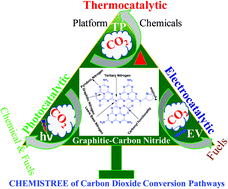Catalytic conversion of CO2 to chemicals and fuels: the collective thermocatalytic/photocatalytic/electrocatalytic approach with graphitic carbon nitride
Abstract
Rapid industrial development and the excessive use of fossil fuels have produced a significantly large volume of CO2 in the atmosphere. The efficient conversion of CO2 to useful chemicals and fuels is an important step towards reducing the concentration of CO2. To overcome the thermodynamic and kinetic barriers involved in CO2 activation and conversion, an effective heterogeneous catalyst and a suitable form of energy, such as thermal, photochemical, and electrochemical, are necessary. Considering a wide variety of catalytic materials for CO2 conversion using all forms of energy resources discussed above, earth-abundant carbon materials have exhibited the capability to catalyze the thermal, photo-assisted, and electrochemically mediated conversion of CO2. Among carbon-based materials, graphitic carbon nitride (g-C3N4) is an inexpensive and sustainable catalyst that can be effectively used for CO2 conversion. The chemical reactivity and optoelectronic properties of g-C3N4 can be finely tailored for its use as a conventional catalyst or photocatalyst or photoelectrocatalyst. This article aims to summarize the synthetic strategies to prepare various types of g-C3N4 materials as conventional catalysts/photocatalysts/electrocatalysts for the improved conversion of CO2 to chemicals and fuels. This article reviews the utilization of CO2 as a feedstock for chemical and fuel synthesis via insertion, carboxylation, and reduction reactions. Further, an in-depth understanding of the catalytic mechanism of various reactions discussed in this article will help in the design of a new generation of heterogeneous catalysts for CO2 conversion. Special emphasis is placed on the various parameters influencing the photocatalytic and electrocatalytic CO2 reduction. Finally, the underlying challenges and outlook for the future development of catalysts for CO2 conversion to specialty chemicals and fuels are discussed.

- This article is part of the themed collection: Celebrating Materials Science in India


 Please wait while we load your content...
Please wait while we load your content...